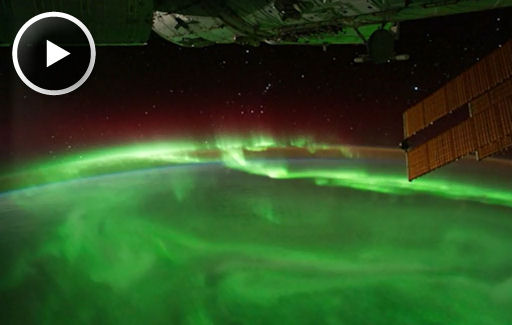| Are we alone? Your iPhone has the answer. Download the all-new Drake Equation app to calculate the population of the Milky Way. | | |
UARS SIGHTED OVER TEXAS: UARS is still in orbit. Observers in central Texas saw it streaking overhead (but not disintegrating) at 8:18 PM CDT on Sept. 23rd (1:18 UTC on Sept 24th).
images: from Adrian New of San Antonio, Texas
NASA STATEMENT: NASA has just issued a new statement on the re-entry of UARS: "As of 10:30 p.m. EDT on Sept. 23, 2011, the orbit of UARS was 85 miles by 90 miles (135 km by 140 km). Re-entry is expected between 11:45 p.m. Friday, Sept. 23, and 12:45 a.m., Sept. 24, Eastern Daylight Time (3:45 a.m. to 4:45 a.m. GMT). During that time period, the satellite will be passing over Canada and Africa, as well as vast areas of the Pacific, Atlantic and Indian oceans. The risk to public safety is very remote."
FAA STATEMENT: A Notice to Airmen (NOTAM) has been posted by the Federal Aviation Administration: "Aircraft are advised that a potential hazard may occur due to reentry of satellite UARS into Earth's atmosphere. FAA is working with the Department of Defense and NASA to ensure the most current re-entry information is provided to operators as quickly as possible. Further NOTAMS will be issued if specific information becomes available indicating a United States airspace impact. It is critical that all pilots/flight crew members report any fallinf space debris to the appropriate ATC facility. The Domestic Events Network telephone 202-493-5107 is the FAA coordination facility. CREATED: 23 SEP 18:33 2011"
AURORAS UNDERFOOT: Solar activity is picking up, and no one has a better view of its effect on Earth than the crew of the International Space Station. During a geomagnetic storm on Sept. 17th, astronauts recorded a must-see movie of auroras dancing underfoot:
 Taken over the southern Indian Ocean, the movie spans a 23-min period from 17:22:27 to 17:45:12 GMT on Sept. 17.
Taken over the southern Indian Ocean, the movie spans a 23-min period from 17:22:27 to 17:45:12 GMT on Sept. 17.Note how the underbelly of the space station glows green from the reflected light of the auroras below. Also, in the distance, Sirius the dog star and Orion the Hunter can be seen rising feet-first into the night sky.
The storm, which registered a moderate 6 on the 0-to-9
K-index scale of geomagnetic disturbances, was caused by a coronal mass ejection (CME) hitting Earth's magnetic field. It was just a glancing blow, but with CMEs that is often enough to spark bright auroras over both ends of Earth. The space station was flying over the southern hemisphere at the time of the display. Observers in the northern hemisphere
saw it too.
A similar storm could be in the offing this week. Another CME is heading toward Earth, and it appears likely to deliver a glancing blow on Sept. 22nd around 23:00 UT. Sky watchers above and below should be alert for auroras.
Aurora alerts: text,
voice.
MAJOR X-FLARE + CME: Yesterday, Earth-orbiting satellites detected a long-duration X1.4-class solar flare coming from sunspot 1302 on the sun's eastern limb. The blast, which peaked at 1100 UT on Sept. 22nd, produced a significant coronal mass ejection (CME). Using data from the SOHO-STEREO fleet of spacecraft, analysts at the Goddard Space Weather Lab have modeled the trajectory of the CME and concluded that the body of the cloud will not hit Earth. A minor glancing encounter with the outskirts of the CME is, however, possible on Sept. 25th. [
CME: movie,
forecast track]
X-flares of Solar Cycle 24: There have been only a half-dozen X-flares since the beginning of new Solar Cycle 24. Here is a complete list so far, all in 2011: Feb. 15 (X2), March 9 (X1), Aug. 9 (X7), Sept. 6 (X2), Sept. 7 (X2), Sept. 22 (X1). Before these six, the previous X-flare occured on Dec.14, 2006, (X1) during old Solar Cycle 23.
Potentially Hazardous Asteroids (
PHAs) are space rocks larger than approximately 100m that can come closer to Earth than 0.05 AU. None of the known PHAs is on a collision course with our planet, although astronomers are finding
new ones all the time.
On September 24, 2011 there were 1250 potentially hazardous asteroids.
Notes: LD means "Lunar Distance." 1 LD = 384,401 km, the distance between Earth and the Moon. 1 LD also equals 0.00256 AU. MAG is the visual magnitude of the asteroid on the date of closest approach.
| | The official U.S. government space weather bureau |
| | The first place to look for information about sundogs, pillars, rainbows and related phenomena. |
| | Researchers call it a "Hubble for the sun." SDO is the most advanced solar observatory ever. |
| | 3D views of the sun from NASA's Solar and Terrestrial Relations Observatory |
| | Realtime and archival images of the Sun from SOHO. |
| | from the NOAA Space Environment Center |
| | the underlying science of space weather |
| | for out-of-this-world printing and graphics |



No comments:
Post a Comment
feel free to give ideas or submit topics